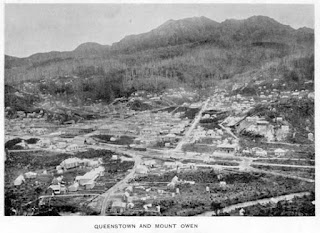The Towns in the Valley
Tasmania's West Coast used to be a very busy place. Zeehan, in its heyday, was the third largest town in
Tasmania, and at the turn of the 19th century Queenstown had
a population of about 5,000. Over the hill in the Linda Valley
Linda, Gormanston and Mt Lyell together had a population of over
2,000.
This is a view of the Linda Valley today, with Gormanston
(centre) at the foot of Mt Owen. Linda consists of three or four
houses and the ruins of the old Royal Hotel on the corner of the road in the left corner of the
photograph.
The rock face in the
foreground is one wall of the old Iron Blow open cut mine.
 |
| down the other side of the hill - approaching Queenstown. It isn't quite raining. |
 |
| Queenstown - dominated by the landscape |
Queenstown
And here are some photographs of what it looks like today.
 |
| view from my window. It's raining |
There is plenty to look
at in Queenstown – the Galley Museum (in the background of this photo) has a splendid collection of –
well – everything.
There are mine tours and monuments and, of
course, the resurrected Wilderness Railway.
|
|
An unexpected find is
the nicely restored Paragon Theatre. Its new owners Francisco and
Fabiola Navidad intend screening films regularly again. You can get a
nice cup of coffee and home-made cake in the cafe while you wait.
|
|
 |
| Late afternoon on Hunter Street – and the sun is shining! Mt Owen is still hidden by clouds, however. |
Once Queenstown was
infamous for its barren hills and lack of vegetation, but today
everything is growing back. And it is encroaching on the town itself.
You mustn't think
Queenstown is all run-down and overgrown, however. I just like that
sort of photograph.
Here's the post office and store in Orr Street, all nicely spic and span.
Here's the post office and store in Orr Street, all nicely spic and span.
Lake Margaret
If you head about ten km north from Queenstown you pass the turnoff to the
Lake Margaret power station. And yes, I am going to show you some
more photographs of penstocks and turbines. Lake Margaret gets the
highest rainfall in Australia after Tully in Queensland. It is a
glacial lake and the source of the Yolande River. In 1914 a concrete
dam raised the water level, and a 2.2 km long wooden penstock
delivered water to the power station below. Originally of Oregon, it
was replaced in 1938 using King Billy Pine and again in 2009 with
Alaskan yellow cedar.
The power station,
constructed in 1914, is the oldest working hydroelectric power
station in Australia, and is on the Tasmanian Heritage Register. The
seven original turbines are still there, still working. Four were
installed in 1914, and the last one in 1929.
Corrugated iron was
used for much building construction; it is durable, easy to transport
and quick to put up.
You can see more photographs of Queenstown and Lake Margaret on my Facebook page - Tasmanian Gothic
You can see more photographs of Queenstown and Lake Margaret on my Facebook page - Tasmanian Gothic


















No comments:
Post a Comment